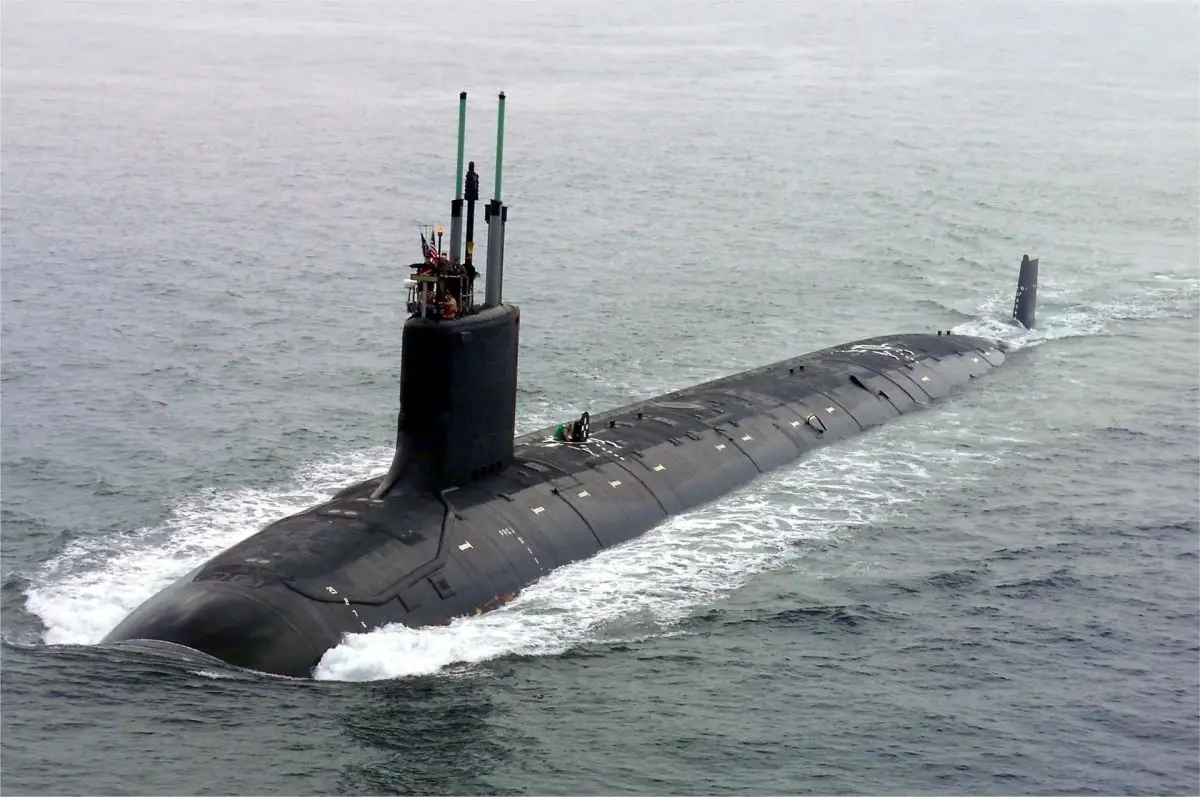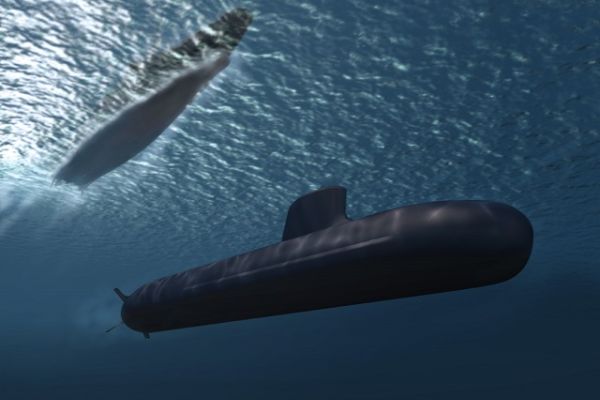Attack submarines.
Virginia-class SSN-774.

The Virginia-class submarines are a series of nuclear-powered fast attack submarines designed and built for the United States Navy. Developed by General Dynamics Electric Boat and Huntington Ingalls Industries, the Virginia class replaces the Los Angeles-class and is intended to maintain U.S. naval superiority in undersea warfare. First commissioned in 2004 with the USS Virginia (SSN-774), these submarines represent the cutting edge in stealth, versatility, and advanced combat capabilities.
Country users : United States
Description
The Virginia-class submarines were designed to perform a wide range of missions, including anti-submarine warfare (ASW), anti-surface warfare (ASuW), intelligence gathering, special operations support, and land attack. They were conceived to meet post-Cold War requirements, emphasizing modular design, cost-effectiveness, and stealth for both blue-water and littoral operations. A defining feature of the Virginia class is its scalability and adaptability, achieved through a modular construction approach. This allows for incremental upgrades in successive production blocks, including the introduction of the Virginia Payload Module (VPM) in Block V variants, which significantly enhances their missile payload capacity. The submarines incorporate extensive stealth measures, such as anechoic coatings, advanced noise-dampening technology, and a pump-jet propulsion system, to make them nearly undetectable to adversaries. Combined with an advanced sonar suite and a versatile array of weapons, the Virginia-class is optimized for dominance in multi-mission roles.
On April 30, 2025, General Dynamics Electric Boat secured a substantial $12.4 billion (€11.5 billion) contract modification from the U.S. Department of Defense for the construction of two additional Virginia-class nuclear-powered attack submarines under the U.S. Navy’s Fiscal Year 2024 procurement plan.
U.S. President Donald Trump on October 20, 2025, publicly reaffirmed the transfer of Virginia-class nuclear-powered attack submarines to Australia under the AUKUS security framework. The confirmation marks a critical milestone in the defense partnership between the United States, United Kingdom, and Australia, transitioning the pact from planning into operational delivery.
List of current Virginia-class submarines with hull number:
- USS Virginia (SSN-774) – Commissioned in 2004, serving in the Atlantic Fleet.
- USS Texas (SSN-775) – Commissioned in 2006, serving in the Pacific Fleet.
- USS Hawaii (SSN-776) – Commissioned in 2007, operating with the Pacific Fleet.
- USS North Carolina (SSN-777) – Commissioned in 2008, assigned to the Atlantic Fleet.
- USS New Hampshire (SSN-778) – Commissioned in 2008, part of the Atlantic Fleet.
- USS New Mexico (SSN-779) – Commissioned in 2010, serving in the Atlantic Fleet.
- USS Missouri (SSN-780) – Commissioned in 2010, operating with the Pacific Fleet.
- USS California (SSN-781) – Commissioned in 2011, assigned to the Atlantic Fleet.
- USS Mississippi (SSN-782) – Commissioned in 2012, serving in the Pacific Fleet.
- USS Minnesota (SSN-783) – Commissioned in 2013, operating with the Atlantic Fleet.
- USS North Dakota (SSN-784) – Commissioned in 2014, first Block III submarine, serving in the Atlantic Fleet.
- USS John Warner (SSN-785) – Commissioned in 2015, operating with the Atlantic Fleet.
- USS Illinois (SSN-786) – Commissioned in 2016, assigned to the Pacific Fleet.
- USS Washington (SSN-787) – Commissioned in 2017, part of the Pacific Fleet.
- USS Colorado (SSN-788) – Commissioned in 2018, serving in the Atlantic Fleet.
- USS Indiana (SSN-789) – Commissioned in 2018, operating with the Atlantic Fleet.
- USS South Dakota (SSN-790) – Commissioned in 2019, assigned to the Atlantic Fleet.
- USS Delaware (SSN-791) – Commissioned in 2020, serving in the Atlantic Fleet.
- USS Vermont (SSN-792) – Commissioned in 2020, operating with the Atlantic Fleet.
- USS Oregon (SSN-793) – Commissioned in 2022, assigned to the Pacific Fleet.
- USS Montana (SSN-794) – Commissioned in 2022, serving in the Atlantic Fleet.
- USS Hyman G. Rickover (SSN-795) – Commissioned in 2023, operating with the Atlantic Fleet.
- USS New Jersey (SSN-796) – Under construction, expected commissioning in 2024.
- USS Iowa (SSN-797) – Under construction, expected commissioning in 2025.
- USS Massachusetts (SSN-798) – Under construction, expected commissioning in 2025.
- USS Idaho (SSN-799) – Under construction, expected commissioning in 2026.
- USS Arkansas (SSN-800) – Under construction, expected commissioning in 2027.
Virginia-Class variants
-
Block I: The initial production group, consisting of four submarines, focused on meeting baseline design and operational requirements. These submarines served as the foundation for further development and introduced modular construction techniques to reduce costs and enable upgrades.
-
Block II: This group incorporated construction improvements, reducing build time and cost while maintaining the same capabilities as Block I submarines.
-
Block III: Introduced redesigned bow sections, replacing the traditional vertical launch tubes with two large-diameter Virginia Payload Tubes, each capable of carrying six Tomahawk missiles. These changes reduced construction costs and increased operational flexibility.
-
Block IV: Focused on lifecycle cost reductions and operational availability. These submarines incorporate design changes to increase the number of deployments between major maintenance overhauls, improving fleet readiness.
-
Block V: Represents a significant enhancement with the addition of the Virginia Payload Module (VPM), increasing missile payload capacity to 40 Tomahawks. This variant further extends the class's capabilities in strike missions while maintaining all prior mission capabilities.
Technical Data
-
Armament
Virginia-class submarines are armed with an array of weapons to execute various mission profiles effectively. They feature four 533mm torpedo tubes capable of launching Mk 48 ADCAP heavyweight torpedoes, which are effective against both surface and subsurface targets. The submarines are equipped with twelve vertical launch system (VLS) tubes for firing Tomahawk cruise missiles, enabling long-range precision strikes against land and sea targets. Block V variants incorporate the Virginia Payload Module (VPM), which adds four additional payload tubes, increasing the missile payload to as many as 40 Tomahawk missiles. For special operations support, the submarines can be fitted with a dry deck shelter (DDS) to deploy SEAL teams and swimmer delivery vehicles. They can also deploy mines for strategic area denial in key maritime regions.
-
Design
The Virginia-class submarines are constructed with a double-hull design made of HY-100 steel, which provides superior strength and durability. Their dimensions are 114.9 meters in length with a beam of 10.36 meters and a submerged displacement of 7,800 tons. The hull incorporates anechoic tiles and quieting technologies to reduce acoustic signatures, making them among the stealthiest submarines in the world. The internal layout is designed to accommodate a crew of 135 personnel, including officers and enlisted sailors. The living quarters are optimized for comfort and efficiency, enabling extended operational deployments. The command-and-control systems use a digital fly-by-wire setup, enhancing maneuverability in confined spaces and shallow waters.
-
Propulsion
The Virginia class is powered by an S9G nuclear reactor, which generates electricity for propulsion and onboard systems. The reactor drives a pump-jet propulsion system, reducing noise levels and enhancing stealth. These submarines can achieve speeds exceeding 25 knots while submerged and operate at depths of over 800 feet (244 meters). The reactor provides virtually unlimited range and endurance, with limitations only imposed by food and crew stamina. This allows the Virginia-class to remain submerged for extended periods, ensuring superior operational flexibility.
-
Sensors and Detection Systems
The Virginia-class submarines are equipped with the advanced BQQ-10 sonar suite, which includes a bow-mounted spherical array, flank arrays, and a towed array for comprehensive underwater detection. These systems are capable of detecting and tracking enemy vessels at significant ranges while maintaining the submarine’s stealth. The AN/BYG-1 combat control system processes sensor data in real-time, enabling quick and precise target engagement. The photonics mast, which replaces traditional periscopes, integrates advanced cameras, infrared imaging, and low-light sensors for superior situational awareness. For communication and data sharing, the submarines feature secure satellite communication systems and high-speed data links. They also include advanced countermeasures and decoys to evade detection and neutralize threats.

Virgnia-class nuclear-powered cruise missile fast attack submarine USS Virginia.
Specifications
-
Type
Nuclear-powered fast attack submarine
-
Country users
United States
-
Designer Country
United States
-
Armament
4 x 533mm torpedo tubes (Mk 48 ADCAP torpedoes), 12 x vertical launch system (VLS) tubes (Tomahawk cruise missiles), Virginia Payload Module (Block V: 40 Tomahawk missiles), Mines and special operations support systems
-
Crew
135 personnel
-
Propulsion
1 x S9G nuclear reactor, pump-jet propulsion system
-
Speed
25+ knots submerged
-
Speed
65 km/h road speed
-
Range
Unlimited
-
Displacement
7,800 tons submerged
-
Dimensions
Length: 114.9 m, Beam: 10.36 m


































